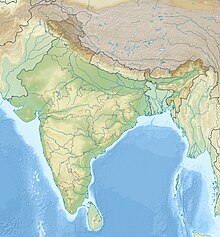| Battle of Assaye | |||||||
|---|---|---|---|---|---|---|---|
| Part of the Second Anglo-Maratha War | |||||||
 Major General Wellesley (mounted) commanding his troops at the Battle of Assaye (J.C. Stadler after W. Heath) | |||||||
| |||||||
| Belligerents | |||||||
|
|
• Kingdom of Nagpur • Gwalior State • Peshwa | ||||||
| Commanders and leaders | |||||||
| Arthur Wellesley |
Anthony Pohlmann Raghoji II Bhonsle Daulatrao Scindia | ||||||
| Strength | |||||||
|
9,500 (including two British infantry regiments and one cavalry regiment) 17 cannon |
10,800 European trained Indian infantry 10,000–20,000 Irregular Infantry 30,000–40,000 Irregular Cavalry 100+ cannon | ||||||
| Casualties and losses | |||||||
|
428 killed[1] 1,138 wounded[1] 18 missing[1] |
Total casualties of 6,000 killed and wounded or 1,200 confirmed killed and many more wounded,[2][3][4] 98 cannons lost | ||||||
Location within India | |||||||
The Battle of Assaye was a major battle of the Second Anglo-Maratha War fought between the Maratha Confederacy and the British East India Company. It occurred on 23 September 1803 near Assaye in western India. An outnumbered Indian and British force, under the command of Major General Arthur Wellesley (who later became the Duke of Wellington), defeated the combined Maratha army of Daulatrao Scindia and the Bhonsle Raja of Berar. The battle was Wellesley's first major victory and the one he later described as his finest accomplishment on the battlefield, even more so than his more famous victories in the Peninsular War, and his defeat of Napoleon Bonaparte at the Battle of Waterloo.
From August 1803, Wellesley's army and a separate force under the command of his subordinate, Colonel James Stevenson, pursued the Maratha cavalry-based army, which had threatened to raid south into Hyderabad. After several weeks of pursuit and countermarching, Scindia reinforced the combined Maratha army with his modernized infantry and artillery as the British forces closed in on his position. Wellesley received intelligence indicating the location of the Maratha encampment on 21 September and devised a plan whereby his two armies would converge on the Maratha position three days later. Wellesley's force, however, encountered the Maratha Army, under the command of Colonel Anthony Pohlmann, a German formerly in British service, 6 miles (9.7 km) farther south than he anticipated. Although outnumbered, Wellesley resolved to attack at once, believing that the Maratha army would soon move off. Both sides suffered heavily in the ensuing battle; Maratha artillery inflicted large numbers of casualties among Wellesley's troops, but the vast numbers of Maratha cavalry proved largely ineffective. A combination of bayonet and cavalry charges eventually forced the Maratha army to retreat, with the loss of most of their guns, but Wellesley's army was too battered and exhausted to pursue.
Wellesley's victory at Assaye, preceded by the capture of Ahmednagar and followed by victories at Argaon and Gawilghur, resulted in the defeat of Scindia and Berar's armies in the Deccan. Wellesley's progress in the Deccan was matched by Lieutenant General Gerard Lake's successful campaigns in northern India and led to the British becoming the dominant power in the heartland of India.
- ^ a b c Millar p. 82.
- ^ Kaushik Roy (2015). Military Manpower, Armies and Warfare in South Asia. Taylor & Francis. p. 86. ISBN 978-1-317-32127-9.
- ^ Holmes p. 81.
- ^ Millar p. 83.
